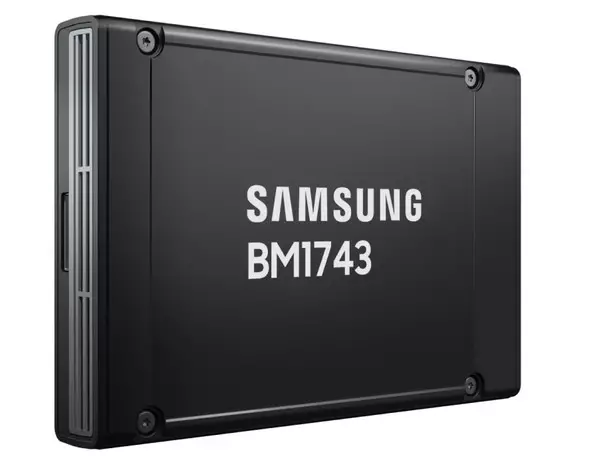Samsung’s 122.88 TB QLC V-NAND SSDs are for the enterprise market
21.08.24
Samsung introduced a new SSD with QLC V-NAND technology, designed for the corporate segment, with a record capacity of 122.88 TB. This drive demonstrates high performance and energy efficiency, which makes it the optimal solution for use in data centers and servers focused on data processing with the use of artificial intelligence.
The Samsung BM1743 model is capable of providing sequential read speeds of up to 7.5 GB/s and write speeds of up to 3 GB/s. The indicators of random read operations reach 1600000 IOPS, and writes – up to 45 thousand IOPS. Compared to previous versions, the new drive offers a 4.1x improvement in I/O performance, as well as a 45% increase in energy efficiency when writing sequentially. These characteristics make it particularly attractive for data centers and cloud services, where both high performance and energy savings are critical.
In addition, Samsung introduced other SSD models, including the PM9D3a and PM1753, which offer a variety of form factors and capacities up to 32 TB. The PM9D3a model demonstrates a sequential read speed of up to 12 GB/s and a write speed of up to 6.8 GB/s. The PM1753, in turn, supports read speeds of up to 14.8 Gbit/s and write speeds of up to 11 Gbit/s. These devices are designed for a wide range of applications, from AI servers to cloud computing.
Interesting about SSD
Kioxia (formerly known as Toshiba), a leading manufacturer of solid-state drives (SSD), has announced drives with an optical interface, designed for ecological data processing centers of the new generation. The technology replaces traditional electrical signals and copper wires with laser and optical cables, which allows storage devices to be placed at a distance of up to 40 meters from servers.
The advantage of optical technology is to optimize the power consumption of data centers due to the increased distance between computing systems that generate a lot of heat and storage that requires minimal cooling. The use of smaller connectors and resistance to electromagnetic interference also contribute to compactness and reduced cable shielding costs.
The technology improves modularity, allowing data centers to expand memory without increasing latency.Future generations of PCIe are also expected to switch to optical interfaces for SSDs, providing faster and more reliable data transfer.
Not only Kioxia works in this direction. Intel is developing optical chips capable of providing 4 Tbit/s connections between CPUs and GPUs. TSMC, in turn, presented a compact universal photonic engine (CPOUPE), which provides an optical connection at the motherboard level at a speed of up to 6.4 Tbit/s. These developments are aimed at meeting the needs for computing power and reducing energy consumption in the context of the growing use of artificial intelligence and data centers.
Don't miss interesting news
Subscribe to our channels and read announcements of high-tech news, tes
Review of Samsung Galaxy A36 and Galaxy A56 smartphones: in a shadow of light

The Samsung Galaxy A36 and Galaxy A56 have equally good displays, large batteries, and support for software updates for 6 years. Let’s talk in more detail about what else makes them interesting.
Ajax Desktop – a new program for managing the system from a PC Ajax applications
Using Ajax Desktop, users can change the security mode of the entire system or individual zones, monitor the status of devices, and receive notifications.
ChatGPT is already used by 500 million users. Paid subscribers are already 20 million artificial intelligence business
Previously, OpenAI completed another round of financing, during which $40 billion was raised.


